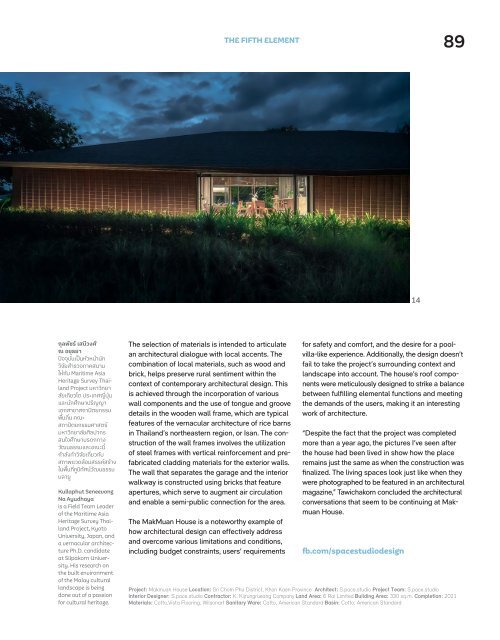ASA Journal 12/2023
You also want an ePaper? Increase the reach of your titles
YUMPU automatically turns print PDFs into web optimized ePapers that Google loves.
THE FIFTH ELEMENT<br />
89<br />
14<br />
กุลพัชร์ เสนีวงศ์<br />
ณ อยุธยา<br />
ปั จจุบันเป็ นหัวหน้านัก<br />
วิจัยสำารวจภาคสนาม<br />
ให้กับ Maritime Asia<br />
Heritage Survey Thailand<br />
Project มหาวิทยา<br />
ลัยเกียวโต ประเทศญี่ปุ ่ น<br />
และนักศึกษาปริญญา<br />
เอกสาขาสถาปั ตยกรรม<br />
พื้นถิ ่น คณะ<br />
สถาปั ตยกรรมศาสตร์<br />
มหาวิทยาลัยศิลปากร<br />
สนใจศึกษามรดกทาง<br />
วัฒนธรรมและขณะนี้<br />
กำาลังทำาวิจัยเกี่ยวกับ<br />
สภาพแวดล้อมสรรค์สร้าง<br />
ในพื้นที่ภูมิทัศน์วัฒนธรรม<br />
มลายู<br />
Kullaphut Seneevong<br />
Na Ayudhaya<br />
is a Field Team Leader<br />
of the Maritime Asia<br />
Heritage Survey Thailand<br />
Project, Kyoto<br />
University, Japan, and<br />
a vernacular architecture<br />
Ph.D. candidate<br />
at Silpakorn University.<br />
His research on<br />
the built environment<br />
of the Malay cultural<br />
landscape is being<br />
done out of a passion<br />
for cultural heritage.<br />
The selection of materials is intended to articulate<br />
an architectural dialogue with local accents. The<br />
combination of local materials, such as wood and<br />
brick, helps preserve rural sentiment within the<br />
context of contemporary architectural design. This<br />
is achieved through the incorporation of various<br />
wall components and the use of tongue and groove<br />
details in the wooden wall frame, which are typical<br />
features of the vernacular architecture of rice barns<br />
in Thailand’s northeastern region, or Isan. The construction<br />
of the wall frames involves the utilization<br />
of steel frames with vertical reinforcement and prefabricated<br />
cladding materials for the exterior walls.<br />
The wall that separates the garage and the interior<br />
walkway is constructed using bricks that feature<br />
apertures, which serve to augment air circulation<br />
and enable a semi-public connection for the area.<br />
The MakMuan House is a noteworthy example of<br />
how architectural design can effectively address<br />
and overcome various limitations and conditions,<br />
including budget constraints, users’ requirements<br />
for safety and comfort, and the desire for a poolvilla-like<br />
experience. Additionally, the design doesn’t<br />
fail to take the project’s surrounding context and<br />
landscape into account. The house’s roof components<br />
were meticulously designed to strike a balance<br />
between fulfilling elemental functions and meeting<br />
the demands of the users, making it an interesting<br />
work of architecture.<br />
“Despite the fact that the project was completed<br />
more than a year ago, the pictures I’ve seen after<br />
the house had been lived in show how the place<br />
remains just the same as when the construction was<br />
finalized. The living spaces look just like when they<br />
were photographed to be featured in an architectural<br />
magazine,” Tawichakorn concluded the architectural<br />
conversations that seem to be continuing at Makmuan<br />
House.<br />
fb.com/spacestudiodesign<br />
Project: Makmuan House Location: Sri Chom Phu District, Khon Kaen Province Architect: S.pace.studio Project Team: S.pace.studio<br />
Interior Designer: S.pace.studio Contractor: K. Kijrungrueang Company Land Area: 6 Rai Limited Building Area: 330 sq.m. Completion: 2021<br />
Materials: Cotto,Vista Flooring, Wilsonart Sanitary Ware: Cotto, American Standard Basin: Cotto, American Standard

















